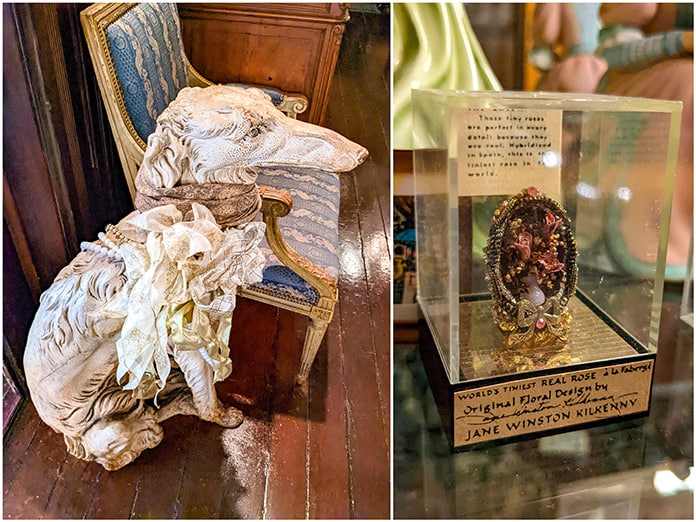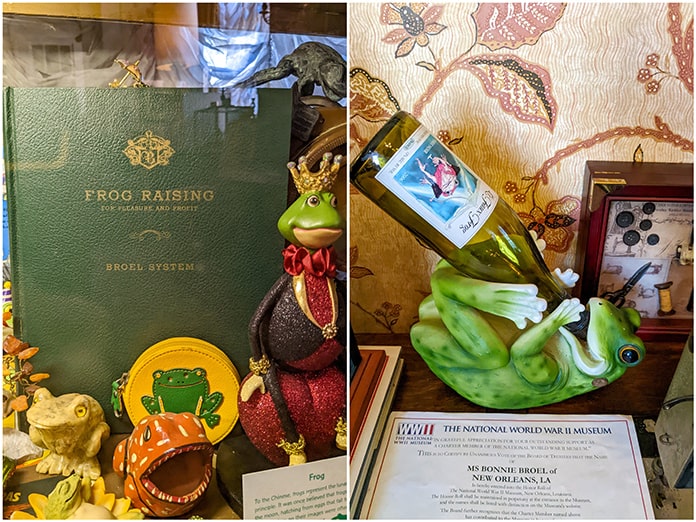
With strains of jazz emanating from darkened clubs and the irresistible smell of Creole cuisine permeating the air, New Orleans nightlife often takes centre stage for its visitors. However, there is a treasure trove of history and human-interest hiding in plain sight in NOLA’s Garden District for those willing to explore this famously nocturnal city from a completely different perspective. Located at 2220 St Charles Avenue, the Victorian façade of House of Broel is indubitably impressive and yet gives no clue as to the veritable treasure trove awaiting discovery upon crossing its historic threshold. From painstakingly decorated dollhouses to Dr Broel’s frog farm, the collections within the mansion invite visitors to step into an alternate world and enjoy a true hidden gem.
For visitors to the Garden District, the exterior of House of Broel may not stand out amongst its similarly-styled neighbouring houses. Formerly comprised of extensive plantations and initially subdivided into large houses with extensive gardens, this part of New Orleans now has some of the best-preserved 19th century Victorian mansions in the Southern United States.
These mansions were developed between 1832 and 1900 as the urban population expanded, mainly commissioned by wealthy Americans who wanted to distinguish themselves from the Creole population of the French Quarter. The 0.5 square kilometre region is easily explored by foot, with St Charles Avenue to the north, Magazine Street to the south, First Street to the east, and Toledano Street to the west.

Exterior of House of Broel in the Garden District
photography by: Daphne Swiateck/ Wikimedia Commons
Located on the northern side of the district, House of Broel was built in 1851 for George Washington Squires as a two-storey Greek Revival style house. In a practice that seems unusual today but which was common in flood-susceptible 19th century New Orleans, the home was lifted by builder James Kelly in 1884, adding a ground floor specifically designed for William Renaud’s family parties such as marriage ceremonies.
This seems almost prophetic, given House of Broel’s present-day popularity as a wedding destination. Notable features of the downstairs area include the exquisite 1890’s tobacco-leaf timber-framed mirror in the entrance hallway and the sparkling crystal chandeliers and original black marble fireplaces of the adjacent Mystic Ballroom. There is also a beautifully maintained garden complete with white wrought-iron furniture. Stepping across the threshold of this historic mansion certainly feels a little like discovering the wedding venue equivalent of Narnia.
Since 1972, the house has been owned by Bonnie Broel, a Polish Countess and famous custom dress designer who is also an author and ordained minister. A long-time resident of St Charles Avenue, Ms. Broel painstakingly restored the mansion to its former glory, retaining as many of the original features as possible.
A unique aspect of the guided tours is the chance to meet Ms. Broel herself and hear a little of her fascinating life story, including the history of her many collections. The Broel Foundation’s primary goal is the preservation of the history and culture of New Orleans, meaning that while the ground floor has been primarily used for weddings since 1992, the upper storeys are the real draw for inquisitive visitors.

Sinéad Browne
photography by: Unique exhibits around the house
The first of the upstairs presentations are the dollhouses: around 60 scale models depicting a variety of scenes, from shops to plantation houses and even a 10ft tall Russian palace with 28 individual rooms, a nod to Broel’s Russian ancestry.
They vary in size but they all have one thing in common: incredible attention to detail, right down to miniscule buttons and handcrafted lace on a pair of ladies’ boots. All of the interiors and costumes are designed and maintained by Ms. Broel herself and are a testament to her commitment to historical accuracy.
Focused on haute couture, the fashion museum is a who’s who of NOLA’s high-society names that have modelled Ms. Broel’s creations over the years. Her own first wedding gown and Mardi Gras Carnival Queen parade outfits are featured, as well as a number of gothic Anne Rice outfits and a unique American flag-themed wedding dress.
Browsing the collection, it is not hard to see how Ms. Broel has gained a stellar reputation in the southern states fashion industry. She is honoured as such by a number of awards, including her 1992 Lifetime Achievement Award from Fashion Group International. The display extends beyond Ms. Broel’s own designs to showcase her interest in worldwide trends; it includes a series of the iconic Franklin Mint porcelain dolls of Diana, Princess of Wales.
One of the most intriguing elements of the residence is a pervasive theme of frogs, culminating in the Louisiana Frog Farm exhibit; a room given over to artefacts that are an ode to Albert Broel, father of Bonnie and kingpin of the frog canning industry in New Orleans in the 1930s.
Mr. Broel’s early obsession with raising frogs resulted in the American Frog Canning Company, located in New Orleans where the supply of frogs was plentiful and live frogs were considered a delicacy for upscale shops like Solari’s delicatessen in the French Quarter. The “Broel System” of frog raising spread worldwide, even as far as Australia.
The accompanying advertisements at the time are nothing short of fascinating, sporting photos of guileless kids holding huge frogs with taglines such as “Even children can handle giant bullfrogs. They are absolutely harmless”. Canned frog legs were also popular, giving access to a wider and more diverse public market via grocery stores.
Eventually the combined effect of his own health issues and a decreasing supply of frogs led Albert Broel to close his factory in the late 1930s, though he continued to breed frogs for a number of years. His legacy lives on as one of the few people to truly make their fortune from this unique industry.

Part of the frog farm exhibit, including Mr. Broel’s instruction manual
photography by: Sinéad Browne
House of Broel is open Monday to Friday, from 11:00am to 3:00pm with visitors granted access through hour-long guided tours. The tours cost $20 for adults and $10 for children and can be booked in advance by email or phone, though walk-ins are accepted. At the time of this author’s visit, payment was by cash only. More information is available on the website.